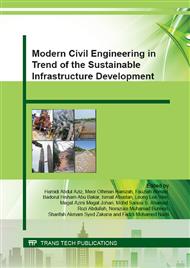[1]
K. Abdullah, M. W. Hussin, F. Zakaria, R. Muhamad and Z. Abdul Hamid, POFA: A potential partial cement replacement material in aerated concrete, In Proceedings of the 6th Asia -Pacific Structural Engineering and Construction, Malaysia, Kuala Lumpur. (2006).
Google Scholar
[2]
W. Tangchirapat, C. Jaturapitakkul and P. Chindaprasirt, Use of palm oil fuel ash as a supplementary cementitious material for producing high-strength concrete, Const. and Building Materials. 23(7) (2009) 2641-2646.
DOI: 10.1016/j.conbuildmat.2009.01.008
Google Scholar
[3]
N. M. Altwair, M. A. Megat Johari and S. S. Hashim, Flexural performance of green engineered cementitious composites containing high volume of palm oil fuel ash, Const. and Building Materials. 37 (2012) 518-25.
DOI: 10.1016/j.conbuildmat.2012.08.003
Google Scholar
[4]
M. A. Megat Johari, A. M. Zeyad, N. Muhamad Bunnori and K.S. Ariffin, Engineering and transport properties of high-strength green concrete containg high volume of ultrafine palm oil fuel ash, Const. and Building Materials. 30 (2012) 281-88.
DOI: 10.1016/j.conbuildmat.2011.12.007
Google Scholar
[5]
V. C. Sata, C. Jaturapitakkul, and K. Kiattikomol, Utilization of palm oil fuel ash in high-strength concrete, J. of Materials in Civil Eng. 16 (6) (2004) 623-28.
DOI: 10.1061/(asce)0899-1561(2004)16:6(623)
Google Scholar
[6]
V .C. Sata, C. Jaturapitakkul and K. Kiattikomol, Influence of pozzolan from various by-product materials on mechanical properties of high-strength concrete, Const. and Building Materials. 21 (7) ( 2007) 1589-1598.
DOI: 10.1016/j.conbuildmat.2005.09.011
Google Scholar
[7]
M. J. A. Mijarsh, M. A. Megat Johari and Z. A. Ahmad, Synthesis of geopolymer from large amounts of treated palm oil fuel ash: Application of the Taguchi method in investigating the main parameters affecting compressive strength, Cons. and Building Materials. 52 (2014).
DOI: 10.1016/j.conbuildmat.2013.11.039
Google Scholar
[8]
M. O. Yusuf, M. A. Megat Johari, Z. A. Ahmad and M. Maslehuddin, Influence of curing methods and concentration of NaOH on strength of the synthesized alkaline activated ground slag-ultrafine palm oil fuel ash mortar/concrete, Cons. and Building Materials. 66 (2014).
DOI: 10.1016/j.conbuildmat.2014.05.037
Google Scholar
[9]
American Society for Testing and Materials (ASTM), ASTM C150/C150M-2009. Standard specification for Poertland Cement, West Conshohocken, PA 55555, US. (2009).
Google Scholar
[10]
B. A. Tayeh, B. H. Abu Bakar, M. A. Megat Johari and A. M. Zeyad, The role of silica fume in the adhesion of concrete restoration systems, in Advanced Materials Research, Trans Tech Publ. 626 (2013) 265-69.
DOI: 10.4028/www.scientific.net/amr.626.265
Google Scholar
[11]
American concrete Institute ACI. ACI-211. 1 - 1991. Standart practice for selecting proportions for normal, heavyweight, and mass concrete. (1991).
DOI: 10.14359/10987
Google Scholar
[12]
British Standards Instituition BS. BS EN 12390-3. Testing of hardened concrete: Compressive strength of test specimens, London, UK: British Standards Instituition. (2009).
Google Scholar
[13]
V. Ajay, C. Rajeev and R. Yadav, Effect of Micro Silica on The Strength of Concrete with Ordinary Portland Cement, Research Journal of Engineering Sciences. 1 (3) (2012) 1-4.
Google Scholar
[14]
S. Rao, H. S. Chandupalle, V. G. Ghorpode and V. T. C. Reddy, Mix Design of High Performance concrete Using Silica Fume and Superplasticizer, International J. of Innovative Research in Science, Eng. and Tech. 3 (3) (2014) 10735-42.
Google Scholar
[15]
M. A. Megat Johari, J. J. Brooks, S. Kabir and P. Rivard, Influence of supplementary cementitiouse materials on engineering properties of high strength conrete, Const. and Building Materials. 25 (5) (2011) 2639-48.
DOI: 10.1016/j.conbuildmat.2010.12.013
Google Scholar


